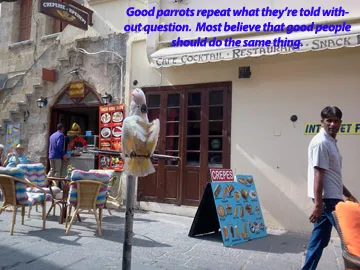False Good or True Good
False goodness is a big trap on the road to freedom. What people consider good according to social standards isn’t real goodness because it has an opposite. It’s based on blindly following social rules. Consequently, many people look good when they aren’t good; often those that look bad are much closer to their True Self. We see and hear what’s on the surface; we feel what’s hidden underneath. False goodness should always produce emotions. It’s our signal that what we’re hearing or seeing is false.
Many leaders, marketers, preachers, gurus, teachers, and inspirational speakers know the power of the false good mask. You might even have friends or family who have a good mask. You actually do them and yourself a favor when you stop falling for their act. But often we fear what lies below the mask, so we refrain from exposing their shadow. In my experience, people usually treat false good people much better than they treat those who are truly good because they’re afraid of the masters of the false good mask. Most people have a deep fear of good people that they ignore because it makes no sense.
If we’re truly observant, we’ll see that what society labels good is the removal or fixing of emotions, which we think happens by fixing the problems (effects). Mom feels lonely, so we go visit her. Our boss is worried about our low numbers, so we work harder. We’re taught that emotions are bad. If we eliminate another’s emotions, we’re good.
But that’s the giant error of the illusion. Emotions are the messenger that points to wrong thinking (beliefs). We’re trained to shoot the messenger and ignore the causal beliefs. Fixing mom’s loneliness or our boss’s worries isn’t our problem. We aren’t the cause of their emotions; their beliefs are.
An Example
Our friend, Jane, feels ugly. She’s put on twenty pounds since her divorce. Stress lines cause her to look older. She believes no one will love her again.
Sally is her friend. Sally listens to Jane and sympathizes with her. Jane likes the attention of Sally’s sympathy. So they bond over Jane’s problem. Sally has been trained to be nice so she says, “Jane, you don’t look bad. What’s not to love about you? You’ll find love again.” She tells Jane what Jane wants to hear. She might also give Jane some beauty tips. Or perhaps she offers to do a makeover for her. Sally appears good because she temporarily removed Jane’s emotions.
Sally’s behavior is socially correct. But she doesn’t help Jane one bit. In order for Sally to inspire or fix Jane’s emotions, Sally has to hold Jane’s problems and beliefs in her mind as true. She’s actually feeding Jane’s false self while appearing to be good, nice, and supportive. If she gives Jane advice, she’s feeding Jane more beliefs. Likewise, giving Jane a makeover will cause Jane to feel good for a day or two, but it won’t cure Jane’s false belief that she’s ugly. Only letting go of the false causal belief will cure Jane. Then she won’t need Sally to inspire her or help her feel good. And therein lies the problem. When we fix the causal belief, we don’t need others. Codependence disappears. We’ve got no one to serve.
Sally has been trained that to be kind and to serve is good and righteous. She feels good when she fixes Jane’s problem or offers advice because she tells herself that she made Jane happy. She didn’t make Jane happy. In truth, Sally covered up Jane’s emotional indicator. She helped her to look away from the cause so now it’s unlikely that the problem will ever go away.
Of course, Sally does wish Jane well. She did what she was trained to do; she was taught that good people inspire and serve others. Real service and true good eventually puts the server out of a job.
When we open our eyes, we realize that what society labels good is actually harmful.
This understanding cures us of self-help gurus and expensive experts. It isn’t anyone’s job to inspire or fix even one other. But we can all help others to find their own inspiration and wisdom by pushing them to let go of their causal beliefs and by letting go of the beliefs we hold in our mind about them.
The Escape
More people are trapped by good than bad. If we’ve gotten stuck in someone’s heroic mission, bought into their get-rich-quick scheme, or play the black sheep in our family, we have to find the beliefs in us that keep us stuck in their illusion. We probably won’t convince the person with the good mask to free us. Ask yourself: “What you think you need or want? What are you hoping to fix? What emotions are you trying to get rid of? What do you think they can do that you can’t?”
If we fall for get-rich-quick schemes, we have a belief in lack. If we’re desperate for a teacher or healer, spent lots of money on the psychic hotline, or have an addiction to self-help books, we believe that we don’t know the answer or can’t heal ourselves. If we hold on to family or friends that mistreat us, we fear being alone. Hidden beliefs are wrapped in emotions so it’s never comfortable to dive into them. But when we see the beliefs and let them go, we’ve eliminated the cause. We no longer need the product or service. The solution will actually look worthless because it is.
We’re often labeled rude or uncaring when we stop blindly obeying the socially-defined good rules. Those who win with the social system, have to make us wrong to keep themselves right. But when we heal this confusion within ourselves, we become truly good and authentic — our own false good mask disappears. Then we never fall for the illusion’s goodness trick again.
